Autumn has arrived and winter is fast on its heels, for me this signals the start of the reef fishing season for pollock and various other species inhabiting these food-rich environments. Pollock are easy to catch with a minimal amount of gear and one of the most enjoyable ways to fish for them is to use soft plastic lures. Here are my top tips for catching these hard fighting fish.
Location, location, location
Pollock like structure. If you can find a mark that has some rough ground, reefs or even a wreck then chances are you will be in for some pollock fishing fun. Reefs can provide particularly good sport in the summer and autumn months for the kayak angler and can often be found close to shore within easy paddling distance of a launch mark. But why reefs? Reefs rise up from the seabed and cause the tide to race up over them. Such a disturbance in water flow brings small food items up from the depths to the shallower water over and around the reefs. This in turn attracts small bait fish and not far behind will be larger predators such as pollock. You will also find pollock in shallow water of less than five metres but these tend to be small juveniles. I tend to look for reefs with a depth of at least 10 m/30 ft when targeting pollock from the kayak but if possible will fish reefs of at least 15 m/50 ft as these tend to hold the bigger fish. Drift fishing works best as you can cover more ground in order to find the feeding fish.
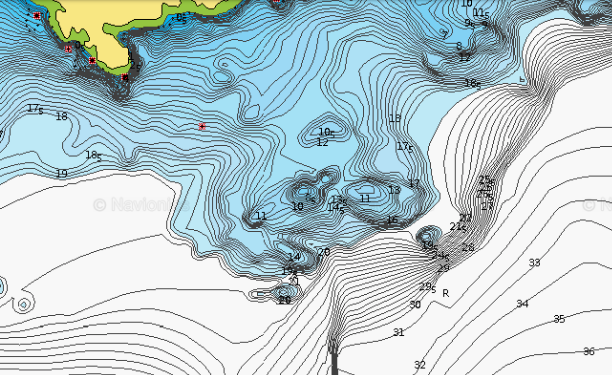
If you have a fishfinder/GPS unit installed on your kayak then locating these features when on the water is easy. If you don’t then you can still put yourself in with a good chance of finding some fish-holding structure by researching your mark before you go. Navionics publish detailed maps of the seabed on their website (see here: webapp.navionics.com) so take the time to study where the best ground is so you know where to head when you launch. Shallow reefs often give themselves away during a running tide by the water that boils around them, and in swell the sea can often be breaking over them. Deeper reefs will be more inconspicuous to the naked eye.
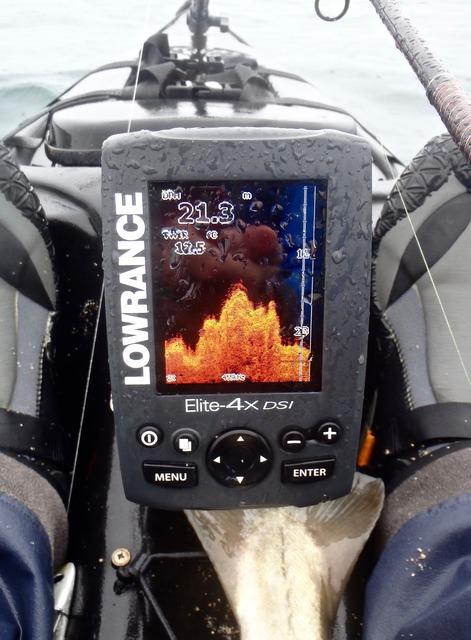
When to fish?
I have found spring tides to be more successful than neap tides but this is not a hard and fast rule. The fish seem to feed best over the reefs when the tide is running, although if there are plenty of fish present the pollock can usually be caught regardless of the tidal state. Time the start of a session at low to mid tide, fishing the tide up and over high. This should give you a good chance of finding the feeding fish at some point during your session. As always, pick conditions within you and your kayaks limits.
Rods and reels
You want a rod that will provide plenty of sport but have the backbone to turn a fish away from potential snags on the bottom when you put the brakes on a crash diving pollock. I find a lure rod with a casting weight of 20-50 gram just about right, although a 6 lb class boat/kayak rod also works well. Pair one of these rods up with a 3000 size fixed spool reel and your rod/reel set up is complete. A fixed spool works much better than a multiplier for lure fishing for pollock, as the line peels off the reel with less resistance allowing a lure to reach the bottom faster with less chance of it being carried off down tide.
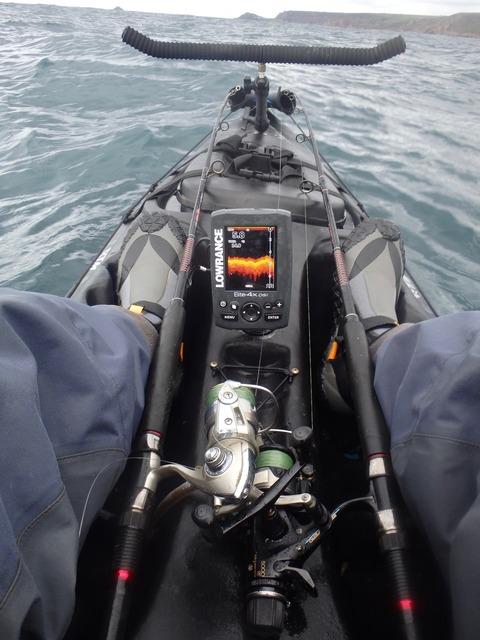
Braid or mono?
I load my reels up with 20 lb braid and consider braid to be fairly essential to successfully fishing with lures in deeper water. The non-stretching braid allows you to feel every pluck and bite from a fish or know when your lure is touching the bottom. The stretch in monofilament line just doesn’t give you the same connectivity with the lure as braid. Braid is also has a thinner diameter than monofilament line of the same breaking strain. This is important when vertical jigging as the thinner braid is less prone to the effects of tide or current dragging the line and lure down tide. I do use a 4 ft length of 20 lb mono leader leading up to the lure just to offer some abrasion resistance, as this area is likely to come into contact with the bottom structure regularly whilst fishing. Braid doesn’t like sharp rocks! I tie the leader to the braid using an Albright Knot – this knot takes a bit of practice to tie but it has yet to fail me.
Lures
When the fish are really on the feed a pollock will take just about any lure that will fit in their mouth!
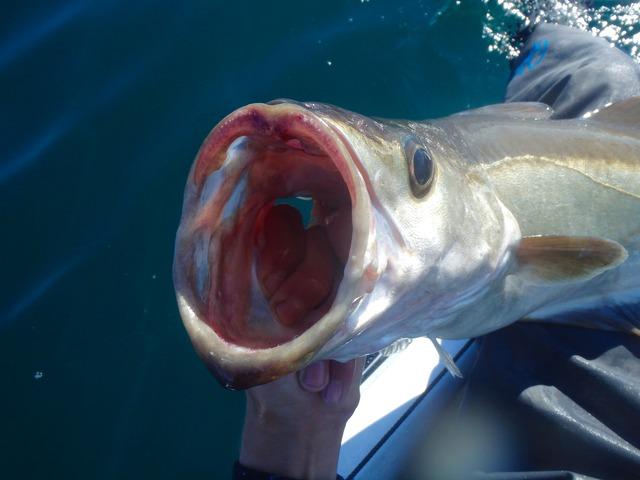
I find that sand eel type lures, such as the Savage Gear sand eels, or minnow imitation lures, such as the popular Fiiish Black Minnow, to work the best.
Weedless lures are favourable as they are less prone to snagging in the weedy/rocky reef structure. These style lures are good because the lead head is a separate component to the soft plastic body. This allows you to change lure bodies whilst fishing should a fish damage the lure or you wish to change the colour of the lure.
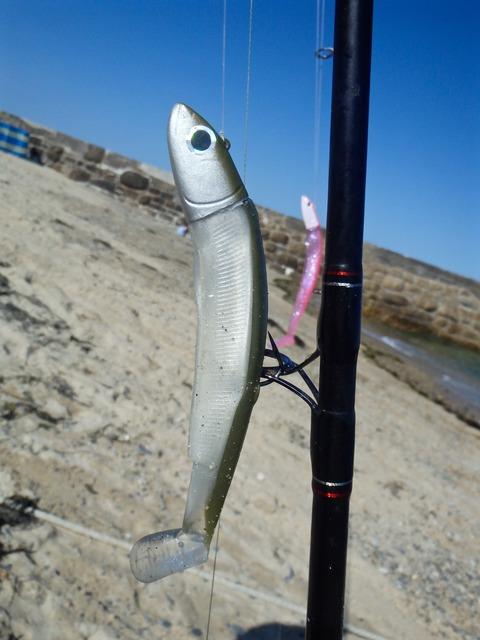
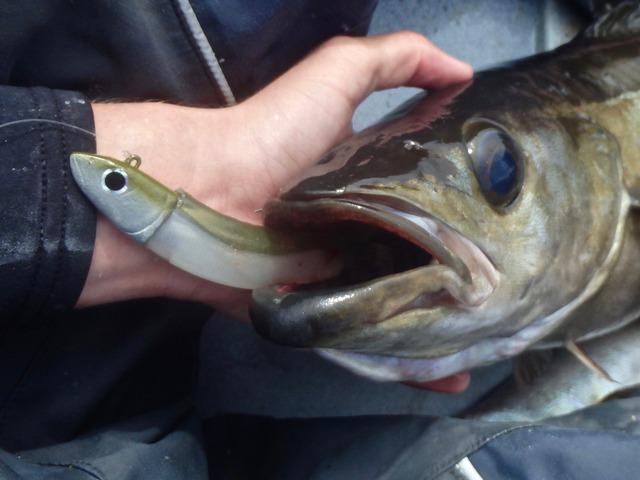
Colour can make a difference to catch rate and it is very much a case of trying a few different colours on the day to see which is working best. I find that white, pink and khaki coloured lures to catch best but I have caught pollock on a whole load of different colour lures. Take a good selection of colours out on the water and this will give you plenty to experiment with.
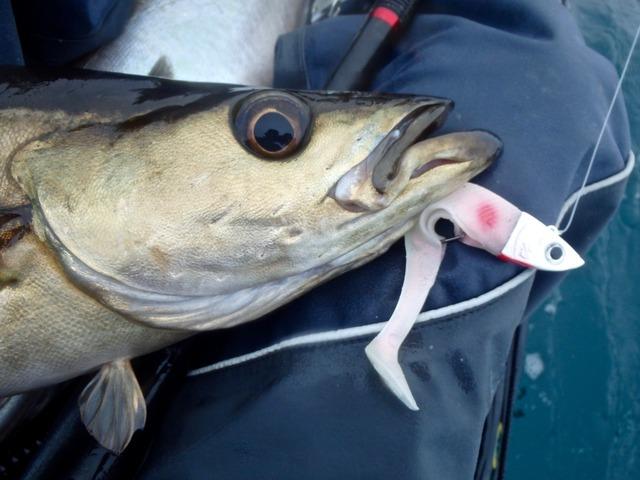
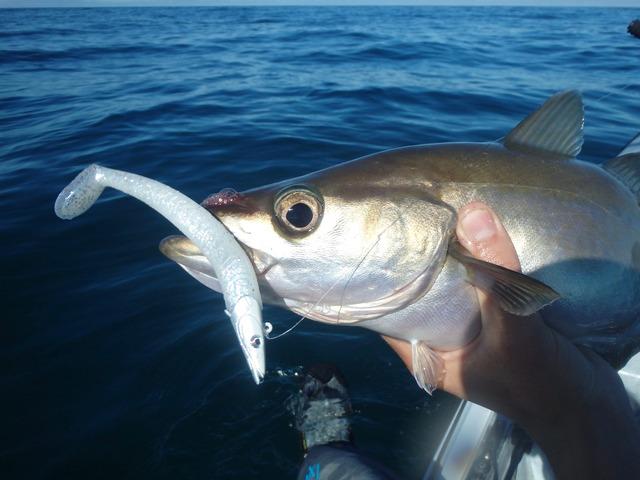
I tend to use lures around 40 grams in weight when vertically jigging and cast/retrieve fishing in less than 15 m of water and lures around 40-80 grams when vertically jigging in 15-35 m of water. The weight required to get the lure to the bottom vertically below the kayak will depend on how much tide is running. The more tide, the heavier the lure needs to be to maintain good connectivity with the lure. Again take a good selection to allow you to experiment.
So you’ve hooked a pollock …
You have your 20-50 gram lure rod teamed up with 3000 sized fixed spool loaded with 20 lb braid with 4 ft 20 lb mono leader. You have paddled out to some reefy looking ground and have tied on your chosen lure. The lure has been lowered to the sea bed some 20 m below, now what?
Slowly retrieve the lure back towards the kayak. You can flick the rod tip to provide additional action to the lure but I often find this is not necessary to tempt a pollock from the depths. Lures with paddle tails, such as the Fiiish Minnow or Savage Gear sand eels, have been designed to swim just like a baitfish on a straight retrieve without additional action. Experiment with winding only half way in and then dropping back to the bottom, or all the way back to the kayak before sending it back down, the fish could be feeding at any level.
Bites will sometimes be small plucks followed by heavy weight as a fish turns with the lure. Sometimes a fish will just hammer the lure at speed. Either way the fish will be wanting to head in one direction … back to the bottom! It is important that you have the drag set on your reel so that a fish can take line. Not so light to let the fish rule the game all the way back to a snag on the bottom, but equally not too tight that the fish struggles to take any line as this may risk a snap off or a hook pull. Pollock tend to have two or three good runs in them before you can bring them to the kayak. Even a small pollock will put up a great account of itself on light gear. If you hook an 5 lb+ fish they can go off like a steam train! If your lucky enough to hook a double figure fish then your in for a proper battle!

If you are fishing shallow ground of less than 15m it can be fun to cast the lure away from the kayak, let it sink some way down and then retrieve. Takes can be electric and the fight particularly good as the fish continually tries to dive towards the bottom as you play the fish towards the kayak.
If the fish aren’t biting try different areas of the mark you are fishing as they may be shoaled up tightly over a particular pinnacle or gully on the sea bed. A change of lure pattern or colour may be all that is needed to tempt a bite. Whichever way you catch them, you can be sure of a smile on your face as the pollock takes off with the lure.
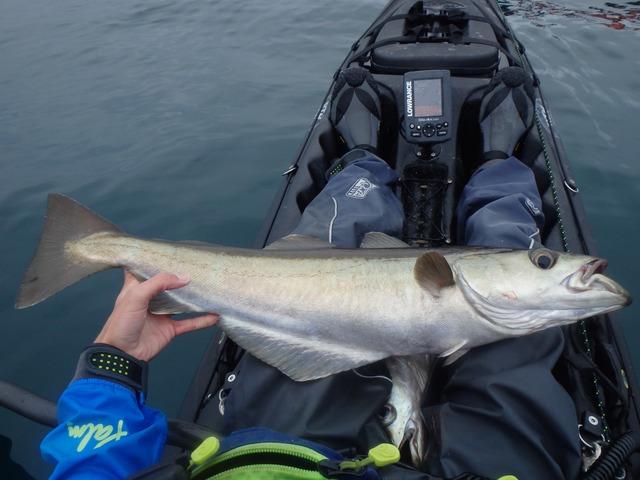
Pollock also make a great eating fish, with similar flesh to that of a cod. In fact pollock and cod are in the same family of fish. They are becoming a more popular eating choice and can often be found on the menu in fish and chip shops, restaurants and are available to buy in some supermarkets – nothing beats fresh though! There are a variety of ways to cook this fish but I recommend keeping it simple, batter a fillet and fry, or cut a fillet into goujons and coat in breadcrumbs before frying. Serve with chips and enjoy!

So what are you waiting for (apart from the weather!) … get out there and catch some hard fighting pollock!